A foam waltz for espresso.
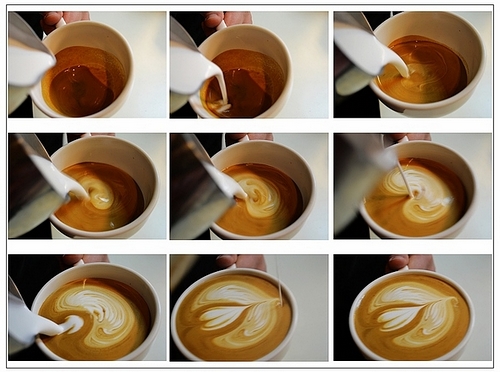
Baristas make leaf-shaped flowers (picture from travellercoffee.pixnet.net)
The Art of Milk and Coffee
There are two main types of Latte Art: Free Pour, which "pulls" patterns while pouring hot milk into espresso, and Etching, which uses accessories such as chocolate sauce and toothpicks to "carve" directly on the foam on the surface of the latte after making the latte.
Compared with carving, the former is more wonderful, while the latter is more versatile. This is because when carving, the foam on the surface of the latte is stable and can support colored sauces such as chocolate sauce and caramel syrup, not only giving baristas more time, but also more freedom in drawing and composition.
The wonder of the flower is that the pattern is formed in the process of preparing the latte. The secret of pulling flowers, experienced baristas may start with how to make espresso and hot milk foam-but physically, what is it all about?
How is the coffee flower formed?
The coffee that makes coffee flowers is called "Espresso", which is what we often call espresso or espresso. This is a kind of coffee with a strong taste, which is obtained by washing the coffee powder under high pressure after being finely ground by boiling hot water. On the surface of espresso is a layer of reddish-brown foam called crema.
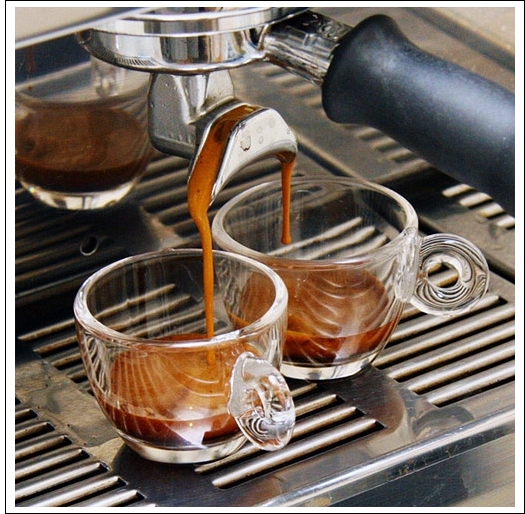
The coffee fat you get when you get espresso (picture from en.wikipedia.org)
The presence of coffee fat is often seen as a sign of the quality of espresso, which accounts for more than 10% of espresso in volume. Coffee fat contains a lot of gases, about half of the total volume.
As shown below, when you look at the structure of coffee fat under an optical microscope, you can see that it contains bubbles, fat particles (usually less than 10 microns), and some solid particles (such as fragments of the cell wall of coffee beans) [1].
The existence of coffee fat is an important factor in the formation of coffee flower.
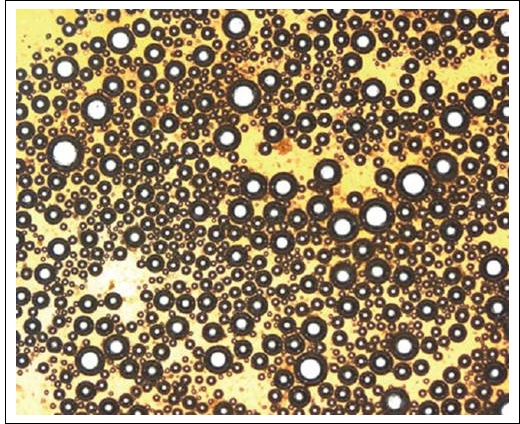
When you look at the coffee fat under an optical microscope, you can see that it contains bubbles, fat particles, and some solid particles such as fragments of the cell wall of coffee beans (photo from Ernesto Illy & Luciano Navarini / Neglected Food Bubbles)
The hot milk used to make coffee flowers is also pre-treated. Through stirring or other methods, the surface of the hot milk forms a layer of milk and air mixed micro-foam (Microfoam).
How to make the foam of milk more and more lasting can also become a subject of scientific research. @ Yun inadvertently did such research, as evidenced by the cappuccino bubble recorded in the laboratory.
In the process of mixing hot milk and espresso, we have two kinds of foam mixed together, one is the mixture of air and milk on the surface of milk, and the other is the mixture of fat, gas and espresso on the surface of espresso. These two kinds of foam are relatively stable, the foam of coffee fat can generally last for about 10 minutes [1], and the foam formed by milk and air can last as long as several minutes [2].
After these two kinds of foams are mixed together, because their particles are very large (both micron-sized) and squeeze together, the diffusion process of the particles is very slow, without stirring. The mixing rate between the two bubbles will be very slow, so the boundary between the bubbles will remain clear for a long time. In this way, the pattern made when the barista pours the milk can be kept for long enough for customers to appreciate.
So the coffee flower is actually a mixture of two foams (not liquids). After knowing this, when I look at the coffee flowers, apart from admiration, does it add another feeling?
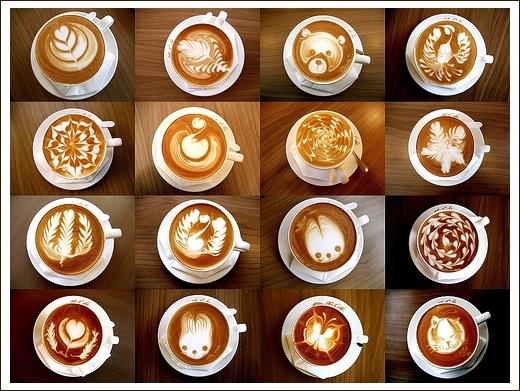
"Latte Art", coffee lace (picture from the Internet)
Some readers may ask, why do bubbles have to be mixed together, but not liquids of different colors?
If there is no foam, when we pour milk into coffee, they are not immediately evenly mixed with each other. Although in detail there are still micron-sized particles inside the two liquids, these particles are not close to each other, and the particles account for only a small part of the liquid and do not have the stability of foam. Therefore, the interface of the mixing of these two kinds of liquids is not only because the internal liquid flow is very unstable, but also becomes blurred quickly because of diffusion, which can not be made into a flower-pulling pattern.
And what we're going to talk about here is the coffee flower thing, it's over.
references
[1] (1,2) Ernesto Illy and Luciano Navarini, Neglected Food Bubbles: The Espresso Coffee Foam, Food Biophysics 6335-3348 (2011).
Felix Sebba, Microfoams-An Unexploited Colloid System, Journal of Colloid and Interface Science 35,643 (1971).
Thank you: I would like to thank you for the guidance and help of rumor shredder editor @ Qiuqiu in the editing process.
The copyright of this article belongs to Fruit Shell Network (guokr.com). Please indicate the source when reproduced. For commercial use, please contact the fruit shell
Important Notice :
前街咖啡 FrontStreet Coffee has moved to new addredd:
FrontStreet Coffee Address: 315,Donghua East Road,GuangZhou
Tel:020 38364473
- Prev
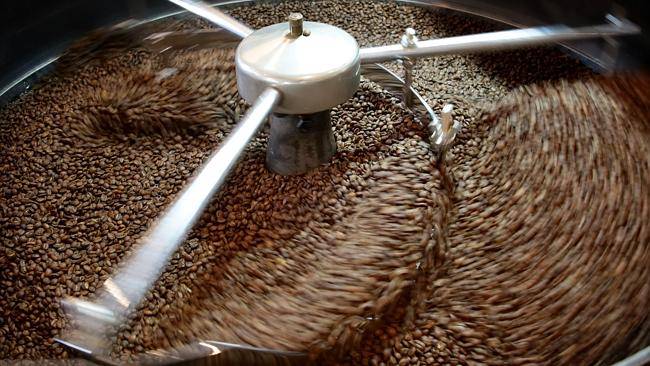
Which can better determine the quality of coffee, raw beans or baked beans?
Nowadays, the process of people's understanding of coffee is very interesting. most people still stay in the situation of adding sugar and milk to coffee. The most direct reason for adding sugar and milk is bitter. Coffee is bitter. Further understanding is that baristas will pull flowers so handsome, pull flowers so beautiful. (inner OS: handsome has nothing to do with whether the coffee is good or not.) it is only when we go a step further that we find that the coffee maker exercises.
- Next
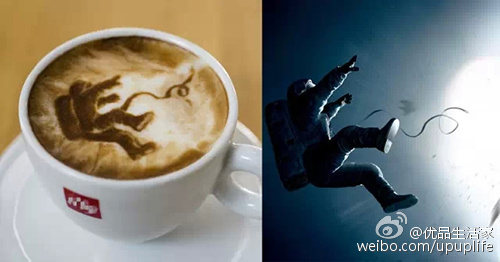
The art of coffee has risen to such a high level! Is there a rising posture?
What can you do with a cup of coffee? Out if you haven't seen it. Come on, take a look at the different coffee flower art, coffee cup art ~ coffee flower art. In New York, there is a guy named MichaelBreach, who is so clever that he can draw lifelike portraits, animal portraits and other patterns on coffee with only a toothpick. In the movie "Gravity Gravity"
Related
- What is the meaning of lactic acid fermentation with coffee bean treatment?
- How to judge the state of foam by sound?
- How does the latte pull out the unicorn pattern? Come to get for a little trick to improve the flower pull!
- Will flower pulling affect the taste of the latte?
- Do you know the history of coffee?
- The difference between honey treatment and sun washing what is raisin honey treatment?
- What kind of milk can a novice use to make coffee foam to keep the foam longer? The correct method and skills of milking tutorial sharing
- Why do washed coffee beans taste sour? Flavor characteristics of washed Coffee
- Introduction to the skill of how to practice the size and height of water injection around the circle of hand-brewed coffee
- How do beginners practice coffee flower drawing from scratch?

